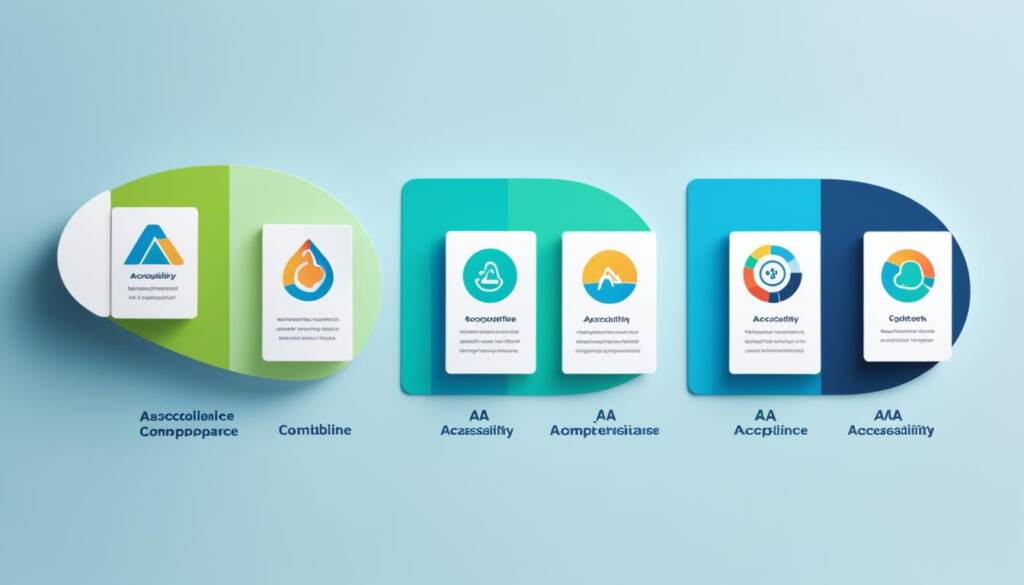Content Accessibility Guidelines (WCAG 2.1) set clear criteria for different levels of compliance. Level A covers basic standards, while Level AA includes more detailed requirements, such as significant color contrast and alt text for images. Level AAA is designed for government agencies and businesses aiming for top accessibility for users with specific disabilities.
It’s important to be aware of WCAG versions and their updates. WCAG 1.0 was released in May 1999, focusing on HTML. It evolved to WCAG 2.0 in 2008, covering more web content needs. WCAG 2.1, released in June 2018, addressed mobile devices like smartphones and tablets. Most recently, WCAG 2.2, from October 2023, added nine new criteria to the guidelines at various levels.

Following these guidelines ensures your business meets ADA standards and protects you from lawsuits. For instance, in 2021, over 11,000 ADA Title III lawsuits were filed, marking a 320% increase since 2013. From January to June 2021, nearly 550 cases were initiated against large companies, almost double that of smaller ones.
Key Takeaways
- Level AA compliance is the most commonly referenced standard in laws and regulations.
- Approximately 96% of U.S. web pages are not accessible to disabled users, highlighting the need for better compliance.
- WCAG 2.2 introduced new criteria to enhance mobile accessibility and the user experience.
- Expert advice is recommended for businesses to effectively follow WCAG recommendations.
- The rise in ADA Title III lawsuits underscores the importance of web accessibility.
What is WCAG?
WCAG stands for Web Content Accessibility Guidelines, providing advice on making web content easier to use. The guidelines focus on four main principles: perceivable, operable, understandable, and robust. Each principle has rules to improve digital content accessibility, such as using text alternatives and captions.
Regular testing is also essential to maintain accessibility. This process should begin in the early stages of website development and include both automated and manual checks.
WCAG Versions and Updates
WCAG has evolved over time to keep pace with new technology. Versions like WCAG 2.0, 2.1, and 2.2 offer different levels of compliance, from A to AAA. Each new version adds more rules and addresses emerging technologies. WCAG 2.2, for example, focuses on mobile use and includes 13 guidelines.
By October 2024, government websites must meet WCAG 2.2 Level AA standards. Until then, WCAG 2.1 Level AA remains the target.
WCAG Level A, AA, and AAA
Different levels of compliance ensure various degrees of accessibility:
- Level A ensures websites are usable but not fully accessible.
- Level AA adds stricter rules for better accessibility, like clear labels and easy navigation.
- Level AAA represents the highest level of accessibility, incorporating all Level A and AA requirements and more.
For example, Level AA requires a color contrast ratio of at least 4.5:1, while Level AAA requires 7:1. Although Level AA is often mandated by law, Level AAA aims for the highest accessibility.
Quote:
“In short, following WCAG 2.0 is key for real digital accessibility and inclusive web design.”
Steps to Ensure AA and AAA Compliance
Achieving WCAG 2.1 AA standards requires a strategic approach. Implementing features for various disabilities is essential to create an inclusive web experience. Below are key steps and tools for achieving Level AA and Level AAA compliance.
Implementing Level AA Guidelines
To reach WCAG Level AA, websites must adhere to stringent design standards, including proper color contrast, alt text, and clear labels. These elements are crucial for making websites user-friendly for everyone, including individuals with blindness, low vision, deafness, and mobility issues. Following these standards helps businesses reach a broader audience.
Advanced Requirements for Level AAA
Achieving Level AAA means meeting all Level AA standards plus additional requirements. This includes higher contrast ratios and sign language for videos. Level AAA ensures full accessibility for all users, even those with less common disabilities. Some organizations or industries aiming for the highest standards may require this level.
Digital Accessibility Tools and Testing
To ensure compliance with WCAG 2.1 AA standards, digital accessibility tools and testing are essential. These tools help identify and fix issues early, ensuring websites are accessible and user-friendly. Regular use of these tools maintains website accessibility and avoids legal problems. Continuous updates improve the web experience for everyone.
In October 2023, WCAG guidelines were updated to WCAG 2.2, keeping accessibility efforts current and addressing new challenges.
Table: Differences Between WCAG Levels A, AA, and AAA
| WCAG Level | Focus | Key Requirements |
|---|---|---|
| Level A | Minimum requirements | Basic web accessibility features |
| Level AA | Inclusive to common disabilities | Enhanced contrast, more comprehensive alt text, structured labeling |
| Level AAA | Most stringent and inclusive | Higher contrast ratios, sign language for media, comprehensive alternatives |
Conclusion
Ensuring ADA compliance and WCAG conformance is more than just a legal requirement; it’s a crucial step toward making the web accessible to everyone. The WCAG standards provide a clear guide: Level A for basic accessibility, Level AA as the primary goal, and Level AAA as the highest standard. Most companies aim for Level AA, which makes websites more usable by ensuring text readability and clear navigation.
Level AAA compliance, while demanding significant design and content changes, represents the pinnacle of accessibility. Incorporating some AAA elements can significantly enhance web usability for people with disabilities. Staying updated with WCAG changes, like WCAG 2.2 and WCAG 3.0, ensures continued compliance and inclusivity.
By focusing on making content perceivable, operable, understandable, and robust, businesses can avoid legal issues and create a welcoming online space. Committing to these standards demonstrates a company’s dedication to making the web accessible to all.
Source Links
- https://www.blueatlasmarketing.com/resources/levels-of-wcag-compliance-and-how-to-optimize-for-aa-vs-aaa/
- https://userway.org/blog/what-are-wcag-2-0-a-aa-and-aaa/
- https://www.gov.uk/service-manual/helping-people-to-use-your-service/understanding-wcag
- https://www.accessiblemetrics.com/blog/what-are-the-levels-of-wcag-compliance/
- https://www.w3.org/TR/UNDERSTANDING-WCAG20/conformance.html
- https://www.weaccess.ai/blogs/wcag-compliance-levels
- https://atelierstudios.com/aa-and-aaa-accessibility/
- https://www.continualengine.com/blog/understanding-wcag-compliance/
- https://sepantapouya.medium.com/navigating-the-nuances-aa-vs-aaa-accessibility-standards-in-ux-design-6fc7a464218d




